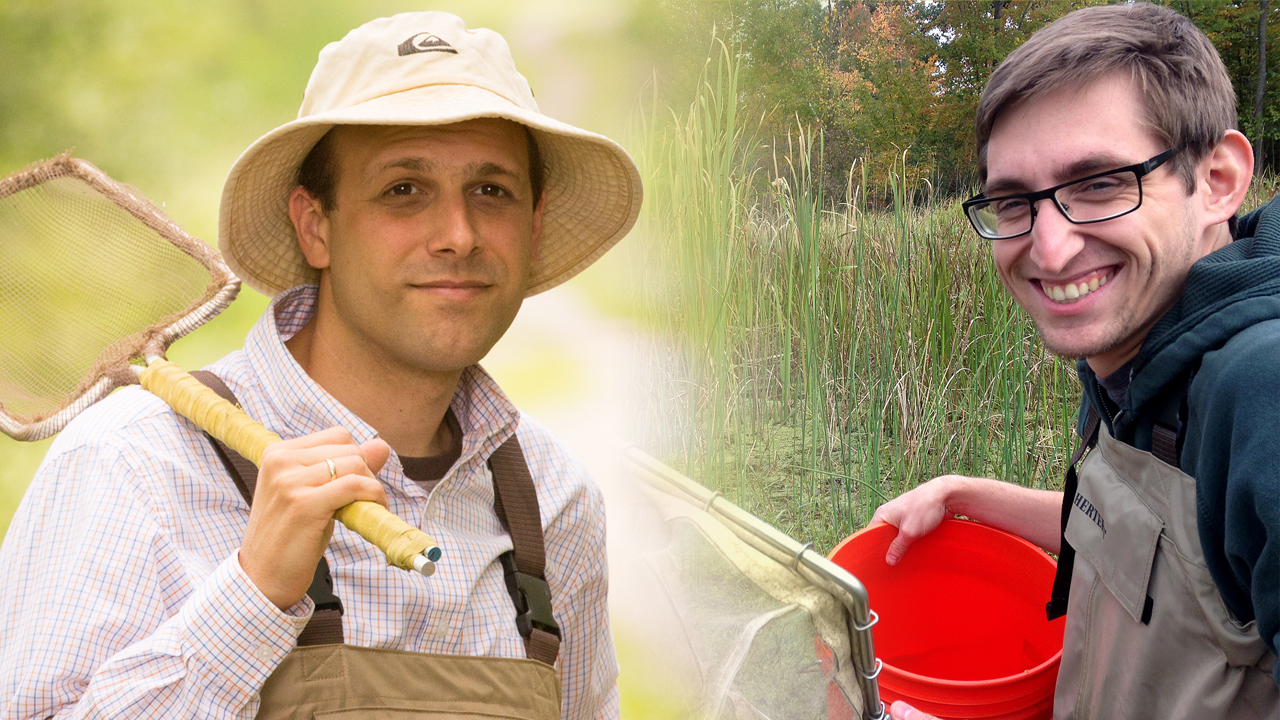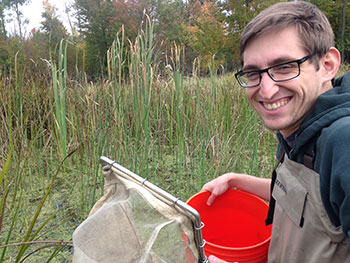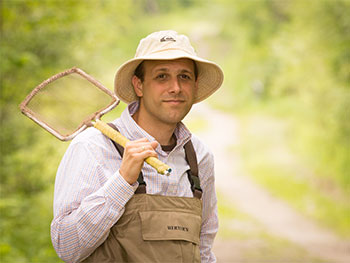OU researchers use statistical models to analyze host-parasite relationships

Researchers in Oakland University’s Department of Biological Sciences have published a study that employs statistical models to analyze host-parasite relationships – in this case between tadpoles (hosts) and flatworms (parasites). The study, published in The American Naturalist, one of the world’s leading peer-reviewed publications in ecology, evolution and behavior research, uses the Metabolic Theory of Ecology (MTE) to describe the role temperature plays in that relationship.
Jason Sckrabulis |
The theory posits that metabolism governs all physiological and ecological rates and that metabolic parameters like temperature can be used as proxies to predict ecological outcomes, such as a parasite infecting a host, or a host resisting infection.
According to the research team, the threat of climate change makes it increasingly important to understand how temperature influences species interactions such as predation and parasitism.
“Changes in temperature have the potential to impact the distribution of many parasites and diseases, such that they may become present in areas historically known to be free of those parasites,” said Dr. Jason Sckrabulis, the study’s lead author and a postdoctoral researcher in Dr. Tom Raffel’s lab at OU.
“Being able to predict the ecological response to shifting temperatures will be critical in managing these shifts. Temperature is a major driver especially of human diseases that include an environmental component, particularly those spread by ticks and mosquitoes.”
Tom Raffel |
Raffel noted the significance of having an article in The American Naturalist, a premier journal for publishing ecological models, and credits Sckrabulis for breaking new ground in the field.
“What’s especially groundbreaking about Jason’s work, is he showed that we can use MTE-based models to separate out a host’s ability to resist infection from the parasite’s ability to infect the host, at a given temperature,” said Raffel. “Ten years ago, I would have said it’s impossible to disentangle these two processes, because parasite infectivity and host resistance are both measured using infection data, and because parasite and host experience the same body temperature simultaneously. Sometimes it’s great to be proven wrong.”
MTE-based modeling also has the potential to help researchers anticipate the effects of parasite infection on a variety of host species, Sckrabulis said.
“The MTE approach also shows that we should be able to measure a host’s respiration rate independently of an infection and predict its response to a hypothetical infection of a parasite. That would make a huge impact on managing concerned or endangered species, or responses to parasites that infect multiple host species.”
Sckrabulis described the framework established in the paper as the foundation of ongoing efforts to describe infection dynamics over time within an entire population of hosts, using a thermal mismatch and MTE model approach.
Moreover, the team’s approach relied on the thermal mismatch hypothesis, which proposes that parasitic infection is the result of the difference in the temperature-dependent responses of parasite and host.
“The main benefit of using MTE inside of a thermal mismatch is that we can use independent metabolic proxies in place of parasite infectivity and host resistance and still model an infection accurately,” Sckrabulis explained.
Using published infection data, along with experiments measuring metabolic responses to temperature in each species, the researchers analyzed interactions between a tadpole and flatworm to show that MTE-based modeling can successfully predict thermal acclimation effects on two stages of parasitic infection.
The researchers used parasite swimming speed as a proxy for parasite infectivity. They recorded 15-second videos of the infective stage of the parasite after it was moved to an experimental temperature. Then, they processed the videos using a software package designed to track moving particles and converted that speed into millimeters per second.
“We were able to calculate the speeds and temperatures at which those speeds are predicted,” Sckrabulis said. “These thresholds were critical in developing our model.”
The research team estimated that the parasite’s infection potential was 0% below a speed of 2mm/sec, at temperatures below 7 C and above 34 C, and 100% above a speed of 3 mm/sec at a temperature range of 17 C to 32 C, in the absence of host resistance.
Similarly, they examined the host’s respiration rate to determine whether it would work as a proxy for host resistance to infection.
“In that experiment, we maintained tadpoles at one of our acclimation temperatures for two weeks,” said Sckrabulis. “They were then placed in a sealed jar at one of the experimental temperatures and we quantified respiration rate by taking a before and after measurement of the dissolved oxygen in the jar over about an hour.”
The researchers found that the pattern of temperature dependence of tadpole respiration rate was qualitatively similar to that of the parasite clearance rate by the host, suggesting that clearance rate is closely tied to overall metabolism.
However, the group found that this comparison did not hold when comparing the temperature effects of respiration rate to the resistance to parasite encystment, where the host’s response occurs within hours and is likely more reliant on defenses that are already present on near the site of infection.
These results show that it is possible to use a metabolic proxy for host resistance, as hypothesized by MTE, but the choice of which metabolic proxy to use is also important.
Along with Dr. Sckrabulis, the study also included co-authors Dr. Raffel and Dr. Karie Altman, who completed her Ph.D. at Oakland in 2018. Sckrabulis is also an OU alumnus, receiving his Ph.D. in 2020.


 February 18, 2022
February 18, 2022
